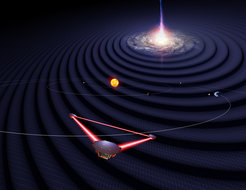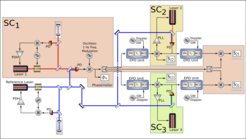Gravitational-wave Astronomy
The department contributes to realizing LISA and supports experiments and studies towards “Beyond LISA” to enable a new mission in the 2050s.
The LISA mission

The department’s main task will be to realize the LISA mission together with Karsten Danzmann’s department as quickly and efficiently as possible. This will happen in close collaboration with space agencies and consortium partners towards a launch in the 2030s.
The department will actively support the institute’s LISA contributions such as the development of the mission’s phase meter, one of the mission’s core hardware components.
In collaboration with the Centre national d'études spatiales (CNES), the AEI will develop LISA’s Interferometry Detection System (IDS), a key deliverable of the mission.
A hardware-in-the-loop simulator
Another LISA-related research project of the department is the development of a hardware-in-the-loop simulator based on the principles demonstrated in the University of Florida LISA Interferometer Simulator (UFLIS). It will allow to explore the intricacies of LISA's interferometry measurement system with simulated as-real-as-possible signals and might be used to test mission hardware components.

UFLIS laid the foundation by providing electronic phase delay units, variable Doppler shifts and simulated gravitational-wave signals to create artificial LISA signals. Using modern field-programmable gate arrays (FPGAs) and digital signal processing systems, which are orders of magnitude more powerful than those used in UFLIS, will allow to simulate close to real LISA signals with electronic phase delay units, variable Doppler shifts, clock signals, ranging methods, a catalogue of gravitational-wave signals, and many other effects.
An important benefit of the hardware-in-the-loop simulator is its ability to provide an excellent training ground for the next generation of students, engineers and scientists. Moreover, this extensive training with a simulated full mission and all its intricacies will help both in tests prior to launch but also during commissioning of the LISA interferometer after launch.
Finally, the simulator will help our scientists gain experience to design and work on a potential mission ‘beyond LISA’.
Beyond LISA
The department will support technology development and advocacy for the next-generation LISA mission which might target gravitational waves at higher deci-Hertz frequencies, i.e. in the 0.01 - 1 Hz band.
Such a mission can profit from the fact that LISA Pathfinder demonstrate the excellent performance of the Gravitational Reference Sensor, which exceeded the LISA requirements by about an order of magnitude. Potential mission designs with necessarily shorter arms will however require significant improvements in the interferometric measurement system and in the phase readout to reach the much lower shot noise limit.
The department plans to initiate a research program to address these challenges.

